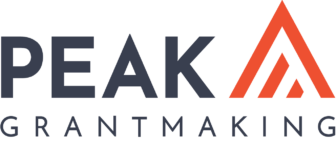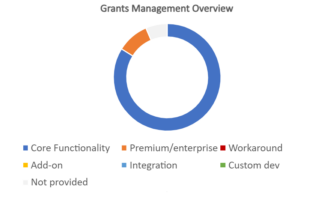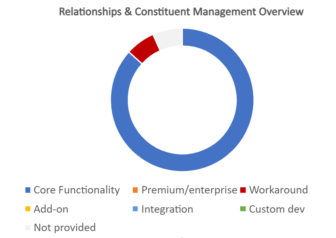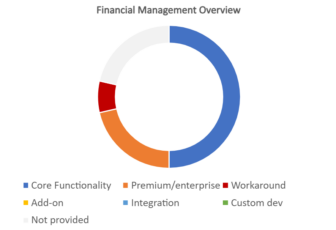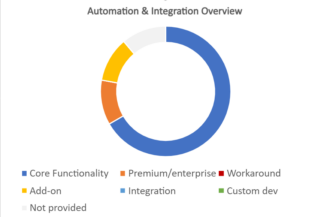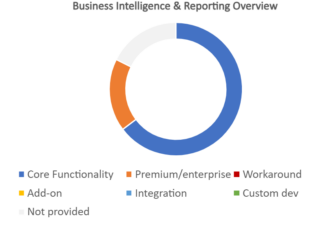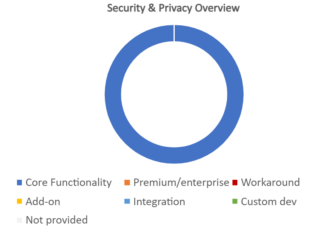Blackbaud Grantmaking is a full-featured configurable system purpose-built for grantmakers. The system lets you track grants, organizations, and relationships with robust custom dashboards and 250 built-in reports. As a product being used by foundations and other grantmakers around the world, the platform supports a variety of currencies and multiple languages and provides access to an international database of nonprofit organizations.
A new applicant and grantee portal released in June 2024 provides a more constituent-centric experience; the portal displays all applications and grants the user has with any grantmaker using the Blackbaud Grantmaking platform.
The system will feel familiar to individuals with experience in other Blackbaud products. A low-priced Basic implementation of the system is available for small foundations looking for out-of-the-box capabilities, while larger grantmakers can get additional features and configurations to accommodate their more complex workflows.
Vendor: Blackbaud
Year Released: 2014
Pricing
Blackbaud Grantmaking offers two packages: Basic and Complete. The Basic package is designed to meet the needs of smaller organizations without complex workflows. The Complete package contains all the functionality of Basic and adds on a reviewer portal, budget module, and branch security. A set number of implementation hours are included in the package price, based on the selected package, and clients can add on extra services if they want to expand the scope of implementation. The vendor does not provide specific pricing for either package.
Estimated Yearly Costs:
- Small Foundation (< $25 million in grants, 1-5 staff): Starts at $4,995
- Mid-Size Foundation ($25-500 million in grants, 10-25 staff): Starts at $17,295
- Large Foundation (> $500 million in grants, 50+ staff): Custom quote
Grants Management
The system includes robust grant management tools. You can track grants through their full lifecycles, from application and review to payments to progress reports. Grant records contain the full content of the application, along with internal comment and discussion fields. Related record links appear in the left sidebar when a record is open, and you can connect grant records to organization records, payment records, activity records, documents, and requirements. You can set up individual workflows for each grant program. Automated charity status and watchlist checks can be performed when grant applications are received or can be manually triggered on organization records.
In June 2024, Blackbaud Grantmaking released a new applicant/grantee portal and application functionality that represents a significant change from its previous approach. The vendor’s new portal is applicant-centric, in that it displays the user’s applications across multiple funders who use Blackbaud Grantmaking. This uses the Blackbaud identity management tool, which means that applicants can use the login they have for their own Blackbaud products to access the portal of any foundation using Blackbaud Grantmaking.
If an applicant is registering for the first time, they cannot prepopulate information in their profile with an EIN, but they can use their profile in Blackbaud’s NPO Connect database to pull in some organization information. When a returning applicant or grantee logs in, they see all the applications they have in progress at the connected foundations as well as any grants that they’ve received and grant payment schedules. They can also use the portal to submit any required reports. To reduce duplicates, if they try to start a new application when there’s already one in progress, the system alerts the applicant about the one in progress so they can continue to use that application rather than starting a new application. Applicants have the ability to make changes to their individual and organization contact information, which are then submitted with the application for review before being updated in the database.
Applications can include eligibility quizzes and multiple stages, forms can be used across multiple programs, and conditional logic lets you create a form that walks applicants through some questions to route them to the correct application for their needs. Multi-stage applications can be prepopulated with information from previous stages. You can add a logo to the application, but there is no ability to change fonts or colors. Forms can include a variety of field types, including calculated fields and a basic sign-and-submit functionality. The system has a size limit of 99MB for individual file attachments on a single application, but there is no limit on the number of documents you can upload. There are no storage limits in Blackbaud Grantmaking.
Applicants need to be online and logged into the system to complete an application, and the system autosaves data as it is entered. Applicants can invite multiple collaborators to work on an application, as long as the foundation allows this functionality to be available for that particular form. Collaborators can be either individuals at the applicant’s organization or individuals outside the organization.
Once an application is submitted, it moves into a holding area for foundation staff to review and add to the database. As part of this review, the system runs a duplicate check and flags any information that may need to be reviewed or updated. If additional information is needed, foundation staff can decide to send the application back to the applicant with a request for updates. Applications can also be sent back to applicants for additional information after they are entered into the system.
After applications are brought into the system, they enter the foundation’s review workflow. Blackbaud Grantmaking allows you to create a variety of different scoring and evaluation rubrics. You can bulk assign reviewers to an application or assign them individually. Administrators can monitor the progress reviewers are making and can message them individually or in bulk as well, if needed. A reviewer portal is available as an optional add-on so the foundation can involve a large number of reviewers in the process. On logging into the portal, reviewers can see applications assigned to them, any announcements or messages from the foundation, and any discussions that they are a part of. Administrators can specify which parts of the application they would like reviewers to see and whether they can see other reviewers’ scores after they submit their review. Reviewers can download applications in a PDF format (which includes attachments) to view them offline but need to be online to enter their scores and comments.
Relationships and Constituent Management
The system supports both organization and individual contact records. You can define a variety of relationships among contacts, including parent/child organization relationships and affiliate relationships. Each record has quick links to related records on the sidebar, including grant requests, payments, requirements, documents, activities, and more. You can log a variety of interactions on the record, including meetings and phone calls; the foundation can define the list of interaction types. Organization records include embedded due diligence capabilities, including a verification of tax status, a Candid GuideStar Charity Check, and international terror watch list checks. You can set up custom fields to collect demographic information on organization records, but the system does not bring this data in from any third-party sources.
You can send emails to individuals and groups through the system. When you click on a record to send an email, you have the option to do a quick send (send the email from your default email program, such as Outlook) or to send from a template. The system supports email, letter, and document templates. A recent document management release provides an integration that includes view and edit capabilities with Microsoft Office documents. While there is no plug-in or integration with Outlook or Gmail, the vendor notes that you can bring emails sent outside the system into the record through drag-and-drop functionality.
You can generate grant summaries and other reports for Board meetings. The system does not include dedicated Board portal functionality, but the vendor reports that you can use the Reviewer portal—an optional add-on at extra cost—to serve as a Board portal as well.
Financial Management
The system provides strong payment scheduling and tracking functionality. You can set a default schedule for grant payments or customize a payment schedule. Payments can be made contingent on the completion of requirements. Payment requests can move through workflows and you can set up automated approvals of upcoming payments. The system securely stores banking information for ACH or wire transfers. There are no pre-existing integrations with accounting software, but you can export and import payment data in CSV format and the vendor reports that you can use Blackbaud’s SKY API to create custom integrations with accounting solutions.
An optional budget module available at an extra cost allows foundations to build out budgets and track payments against those budgets. As grants are awarded, you can apply the payments against budget line items and track your drawdowns. If you have a percentage goal for granting, there is a dashboard ticker that will show your progress toward that goal. The budget module also allows you to do forecasting. If you have a grant payment that you want to split between two different budgets, you will need to do a bit of a manual workaround by splitting the payment into two different records, one for each budget.
Automation and Integration
You can set up a wide variety of workflows organized by grant program in the system. A workflow dashboard lets you track where records are in the various stages of workflow. You can move records along the workflow manually or you can set up automations that move the records along based on another action in the system. Automated emails can be set up for notifications, actions, and reminders. You can schedule them in the system or set them up when creating a new grant application.
Blackbaud’s SKY API continues to be expanded, and the Grantmaking product has payment endpoints and organization endpoints set up in the system. In June 2024, the vendor released additional endpoints for requests, activities, contacts, and requirements. Additionally, SKY add-ins allow developers to build integrations that look native to the platform, and the vendor reports that it is in discussions to expand the integrations available for Blackbaud Grantmaking.
Several types of batch updates can be made in the system, including generating correspondence, task assignments, reviewer assignments, and status updates. You can also do batch updates for several attributes and actions on payment records. The system currently has pre-built integrations with Blackbaud Raiser’s Edge NXT and Candid GuideStar Charity Check, and other integrations can be creating via the API.
Business Intelligence and Reporting
A universal search bar allows for quick searches for requests (grants and applications), organizations, and contacts, with a full system search link as well. The full system search does not include the contents of attachments uploaded to the system. Searches can be done with partial matches, but there is no fuzzy search functionality.
System dashboards are all configurable by individual users, and users can create their own dashboards and share them with other users. The vendor does provide some standard dashboards that are delivered at time of implementation. You can add parts (widgets) and tabs to dashboards. A team dashboard can be shared with other team members to monitor KPIs and other relevant metrics. Dashboards can include charts and graphs, lists, and other types of visualizations. You can drill down to the underlying records by clicking on a visualization.
The system comes with 250 standard reports. Standard reports cannot be copied, but users can change and update the filters. Ad hoc reports can be built using the full system search interface and adding filters to focus on the criteria you want. You can copy and edit ad hoc reports to create new ones. Reports can be scheduled and can also be exported in a variety of formats: PDF, HTML, text, Word, Excel. There’s no limit on number of reports in the system.
You can use the system ad hoc reporting to create your own outcomes or impact reports based on data collected from grantees. There is also an optional add-on at an extra cost that is focused on outcomes reporting, which is built to correspond to the data and outcomes that comprise the United Nations Sustainable Development Goals.
Technical Considerations
Blackbaud Grantmaking and the new grantee portal are mobile-friendly so that it displays across a variety of devices. The system is not WCAG 2.1 compliant, but the vendor notes that accessibility features are on the development roadmap.
Foundations can set up their own taxonomies during implementation, but the optional Outcomes module does come with the U.N. Sustainable Development Goals pre-loaded.
As a system with a large international presence, Blackbaud Grantmaking accommodates a wide variety of currencies. You can specify on a per-program basis which currency types you want to show, but the system does not have exchange rates built into the tool. The vendor reports that it has built simple custom calculate exchange functionality for customers in the past. The applicant/grantee portal accommodates multilingual content provided by the foundation. Applicants can choose their preferred language from the ones enabled by the foundation. An in-system AI translation function can help foundations by taking the first pass at translating the content, which the foundation can then fine tune in the software.
Security and Privacy
Blackbaud’s Security and Privacy policies provide a detailed guide to how data is secured and protected across the company’s many software platforms. Administrators have the power to grant, limit, or restrict user access to a wide variety of system functions. An audit log records all system access, actions, and changes. Login security is protected by multi-factor authentication and single sign-on is available. All system data is encrypted at rest and in transit.
Training and Support
|
|
Included | Additional Cost |
Not available |
|
Phone |
X |
|
|
|
Chat |
X |
|
|
|
|
X |
||
|
Knowledgebase |
X |
|
|
|
Training Videos |
X |
|
|
|
User Community |
X |
|
|
|
Implementation |
X |
|
Phone and chat support is available for all foundation clients. Applicants having problems with the portal need to go through the foundation for support. Live support is available Monday through Friday 8:30 a.m. through 6 p.m. ET, excluding holidays. There is also a knowledgebase, user community, and recorded training videos. BlackbaudU offers some free training and several subscription levels for more in-depth coursework. Implementation hours for new clients are included in the yearly subscription price, and foundations can purchase additional implementation support hours as needed.
Customer Experience Survey
Number of Survey Respondents Using the System: 23
Percent Who Would Recommend The System: 65.4
Training Rating: 2.74/4
Implementation Rating: 2.96/4
Support Score: 2.58/4

